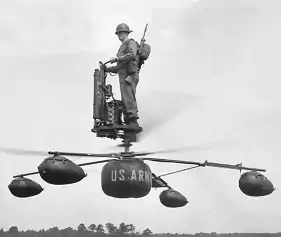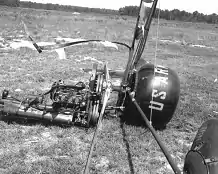de Lackner HZ-1 Aerocycle
The HZ-1 Aerocycle, also known as the YHO-2 and by the manufacturer's designation DH-5 Aerocycle, was an American one-man "personal helicopter" developed by de Lackner Helicopters in the mid-1950s. Intended to be operated by inexperienced pilots with a minimum of 20 minutes of instruction,[1] the HZ-1 was expected to become a standard reconnaissance machine with the United States Army. Although early testing showed that the craft had promise for providing mobility on the atomic battlefield, more extensive evaluation proved that the aircraft was in fact too difficult to control for operation by untrained infantrymen, and after a pair of crashes the project was abandoned. A single model of the craft was put on display.
| HZ-1 Aerocycle | |
|---|---|
 | |
| Role | Experimental rotorcraft |
| National origin | United States |
| Manufacturer | de Lackner Helicopters |
| Designer | Lewis C. McCarty Jr. |
| First flight | 22 November 1954 |
| Primary user | United States Army |
| Number built | 12 |
Design and development
During the early 1950s, Charles H. Zimmerman of the National Advisory Committee for Aeronautics (NACA) developed a system for control of a rotorcraft in which, with the rotors mounted on the underside of the aircraft, the machine could be steered by the pilot through the simple shifting of his weight,[2] and kept stable through the actions of his natural reflexes.[3] Known as kinesthetic control, and similar in principle to the mechanics of riding a bicycle or a surfboard,[3] it was hoped that the concept would allow for pilots to operate an aircraft with little to no training time.[4] NACA testing proved that the idea had merit, and several companies, including Bensen Aircraft, Hiller Aircraft, and de Lackner Helicopters, began development of rotorcraft using the concept.[2]
The concept proposed by de Lackner Helicopters was a one-man flying platform, and it received the company designation "DH-4". The DH-4 was expected to be able to carry up to 120 pounds (54 kg) of cargo[4] or an auxiliary 5-US-gallon (19 l; 4.2 imp gal) fuel tank to extend its range up to 50 miles (80 km)[5] in addition to its pilot, a cargo lifting line could be threaded through the rotor shaft for the carrying of slung loads underneath the craft.[5]
The machine was a simple, cross-shaped frame, with the pilot standing on a platform, secured by a safety harness. The harness also secured the aircraft's engine, which was an outboard motor manufactured by Mercury Marine.[5] The engine was controlled by a twist-grip motorcycle-style throttle[6] and transferred power to the 15-foot (4.6 m) diameter, contra-rotating rotors via belt drive[2] with a chain reduction unit.[7] The aircraft's landing gear consisted of airbags at the end of each arm of the frame along with a large rubber float in the middle, allowing for amphibious capability,[5] although this arrangement was later replaced by a pair of conventional helicopter-type skids.[8]
Testing

Originally designated YHO-2 by the U.S. Army, then later re-designated HZ-1 and named "Aerocycle", the prototype made its first tethered flight on 22 November 1954,[9] with its first free flight taking place in January 1955 at the Brooklyn Army Terminal.[2] Over 160 flights totaling more than 15 hours of flight time were conducted,[9] and the results of this early test flight program were considered promising enough that a dozen examples of the type were ordered[2] (serial numbers 56-6928 to 56-6939).[10] Predictions were made that the craft could provide transport to a modern version of the old horse cavalry, providing airborne "eyes and ears" for the Army.[11]
In 1956, the test program was transferred to Fort Eustis, Virginia, where Captain Selmer Sundby took over test-flying duties.[2] The HZ-1 had been designed to be very easy to fly, and early testing indicated that untrained soldiers could learn to operate the craft in less than 20 minutes,[6] and some claiming that only five minutes of instruction were required.[12] In addition, the HZ-1 proved to be faster than other flying platform designs evaluated by the Army.[2] Sundby, however, quickly determined that the craft was much more difficult to fly than had been expected,[2] and would not be safe in the hands of an inexperienced pilot.[2] In addition, the low-mounted rotors proved to be prone to kicking up small rocks and other debris.[4]
Over a series of tethered and free-flying test flights lasting up to 43 minutes, the HZ-1 suffered a pair of accidents. Both crashes occurred under similar conditions – the contra-rotating rotors intermeshed and collided, the blades shattering, causing an immediate loss of control resulting in a crash.[2] Aerodynamic testing was conducted in the full-scale wind tunnel at the Langley Research Center, and it was discovered that the Aerocycle's forwards speed was limited by an uncontrollable pitching motion, but rotor-tip clearance was always sufficient.[13] The inability to determine the precise cause of the intermeshing, combined with the fact that the "personal lifting device" concept was failing to live up to its expectations, led to the decision to terminate the project.[2]
Sundby was awarded the Distinguished Flying Cross for his test-flying work with the HZ-1,[2] going on to test-fly the H-21 and H-34 helicopters, as well as seeing combat in the Vietnam War before retiring with the rank of colonel.[14]
Parachute development

An entirely new type of parachute with extremely fast opening characteristics, the "Ultra-Fast Opening Personnel Parachute Type XMP-2", was developed for use in testing of the HZ-1 and Hiller VZ-1 flying platforms. Designed for use from 0 to 50 miles per hour (0–80 km/h) and at altitudes as low as 25 feet (7.6 m), the XMP-2 proved to have insufficient reliability for use as a personnel parachute.[15]
Variants
- DH-4 Heli-Vector
- Initial prototype of the Aerocycle design; one built.[16]
- DH-5 Aerocycle
- Company designation for the development prototype of the HZ-1.
- HZ-1 Aerocycle
- the limited production aircraft delivered to the US Army; 12 built.
- HO-2 Aerocycle
- Designation in the US Army HO series
Aircraft on display
Of the dozen examples of the type ordered by the U.S. Army, only a single example of the HZ-1 has survived, and this aircraft is currently on display in the U.S. Army Transportation Museum at Fort Eustis, Newport News, Virginia.[2]
Specifications (HZ-1 Aerocycle)
General characteristics
- Crew: 1 (pilot)
- Height: 7 ft (2.1 m) from air bags to handle bars
- Empty weight: 172 lb (78 kg)
- Gross weight: 454 lb (206 kg)
- Fuel capacity: 1 US gallon (3.8 l; 0.83 imp gal)
- Powerplant: 1 × Mercury Marine 20H outboard motor, 40 hp (30 kW)
- Main rotor diameter: 2× 15 ft (4.6 m)
Performance
- Maximum speed: 75 mph (121 km/h, 65 kn)
- Cruise speed: 55 mph (89 km/h, 48 kn)
- Range: 15 mi (24 km, 13 nmi)
- Endurance: 45 minutes
- Service ceiling: 5,000 ft (1,500 m)
See also
Aircraft of comparable role, configuration, and era
Related lists
References
- Notes
- Hearst Magazines (April 1956). "Aerocycle Lifts Soldier". Popular Mechanics. Hearst Magazines. p. 88.
- U.S. Army Transportation Museum
- Hiller Aviation Museum
- Goebel 2011
- Mechanix Illustrated 1955
- Flight and Aircraft Engineer, 2 November 1956, p. 724.
- Champlin 1953
- Harding 1997, p. 112.
- The Aeroplane, v. 88, 1955. p. 443.
- Heyman and Parsch 2004
- Corn and Horrigan 1996, p. 127.
- The AOPA Pilot, v. 15, 1955.
- Coleman 1997, p. 4.
- "Selmer A. Sundby". U.S. Army Aviation Museum website. Accessed 27 May 2010.
- "Ultra-fast Opening Personnel Parachute Type XMP-2". Defense Technical Information Center. Accessed 27 May 2010.
- Bridgman, Leonard, ed. (1956). Jane's All the World's Aircraft 1956-57. London: Sampson Low, Marston & Company, Ltd. pp. 263–264.
- Bibliography
- "Flying Platform". San Carlos, CA: Hiller Aviation Museum. November 1999. Archived from the original on 11 June 2010. Retrieved 27 May 2010.
- "The de Lackner Aerocycle – An early "Flying Platform"". Fort Eustis, VA: U.S. Army Transportation Museum. Retrieved 27 May 2010.
- "Stand Up and Fly". Modern Mechanix. Robbinsdale, MN: Fawcett Publications. August 1955. Retrieved 27 May 2010.
- Champlin, G.F. (1953). "de Lackner DH-4". American Helicopter. New York: American Helicopter Magazine, Inc. 33–40: 104. Retrieved 29 September 2011.
- Coleman, Colin P. (1997). A Survey of Theoretical and Experimental Coaxial Rotor Aerodynamic Research (PDF). Moffett Field, CA: NASA Ames Research Center. NASA Technical Paper 3675. Archived from the original (PDF) on 22 May 2012. Retrieved 3 December 2010.
- Corn, Joseph J.; Brian Horrigan (1996). Yesterday's Tomorrows: Past Visions of the American Future. Baltimore, MD: Johns Hopkins University Press. ISBN 0-8018-5399-0.
- Goebel, Greg (1 May 2011). "The Flying Platforms & Jeeps". VectorSite. Archived from the original on 24 October 2011. Retrieved 26 October 2011.
- Harding, Stephen (1997). U.S. Army Aircraft Since 1947. Atglen, Pennsylvania: Schiffer Publishing Ltd. ISBN 0-7643-0190-X.
- Heyman, Jos; Andreas Parsch (2004). "Duplications in U.S. Military Aircraft Designation Series". designation-systems.net. Retrieved 3 December 2010.
- Smith, Maurice A., ed. (2 November 1956). "Helicopters of the World: de Lackner Helicopters Inc". Flight and Aircraft Engineer. London: Hiffe and Sons Ltd. 70 (2493). Retrieved 29 September 2011.
External links
| Wikimedia Commons has media related to HZ-1 Aerocycle. |
- "The Sky-High Invention" on howtoadvice.com
- Science: Vertical Mobility. TIME, 9 January 1956.